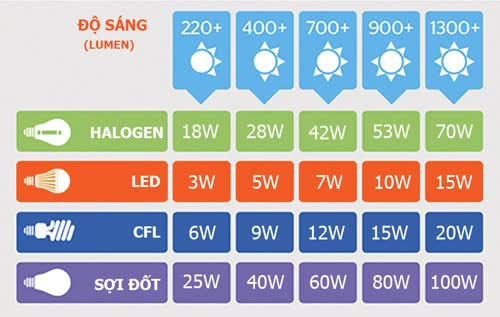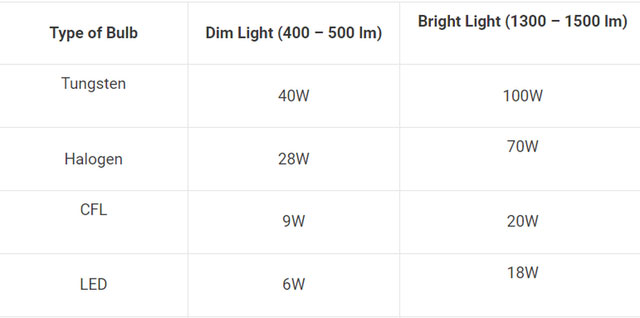Which type of light bulb is the most economical to use?
Light bulbs are one of the devices that contribute significantly to a family's monthly electricity bill.
Specifically, according to Vietnam Electricity Group EVN, lights will consume 10-15% of a family's electricity costs. However, if you know how to use it correctly and choose the right type of light bulb, you can save up to 70% of electricity.
Currently on the market there are many different types of light bulbs and electric lights such as LED bulbs, Halogen bulbs, CFL compact bulbs, fluorescent bulbs and incandescent bulbs. Among them, LED light bulbs are the type that use the least amount of energy when operating, helping to save the best electricity.
Specialized sites have measured over 5 lighting levels of different types of light bulbs to provide specific comparison tables, helping users more easily visualize the electricity consumption between different types of lights.


It can be seen that incandescent bulbs consume 25W of electricity at the lowest lighting level of 220+, and 100W at the highest lighting level of 1300+, so they consume the most electricity.
The light bulb that consumes the least amount of power and is the most economical is the LED light bulb that consumes only 3W when at a lighting level of 220+, and 70W when at a lighting level of 1300+.
Tips to save electricity when using lighting
In addition to using LED light bulbs, people can follow some tips to use the home lighting system to be more economical.
1. Do not turn the light off and on again continuously
Turning off the light bulbs when leaving the room, even if it's only for a short period of time, and turning the lights on when you return is a habit of many people. But this does not help save electricity but is also counterproductive and causes the light bulb to shorten its lifespan.
Therefore, if you only leave the room for 5-15 minutes, it is not necessary to turn off the lights.
2. Install separate switches for each type of light
You should install separate switches for each type of light in each different area of the house to help the lights be used for the right purpose, at the right time, in the right place and the family does not waste electricity.
3. Use troughs/reflectors when installing lights
The light trough and reflector help distribute light from the bulb, protect the bulb and position the light, support the ballast, and connect the light to the power source.
Experts say that the trough and reflector will help the bulb have the highest level of illumination and reflection.
4. Take advantage of natural light during the day
Take advantage of natural light sources during the day, limit turning on too many lights in the house.
You should read it
- When you turn off the light in the room, where did the light go?
- Fix flashing electric light
- The best LED light bulb for every room in your house in 2020
- Instructions for homemade readers to clap the device to turn on the lamp / fan very simply
- 20 interesting facts about light you may not know
- What is Li-Fi?
- The strange energy beam moves faster than the speed of light, moving in a spiral form
- How to manually turn off the power light and hard drive light on the desktop
May be interested
- Light Shop: Evaluating the pros and cons of a film that is expected to be as successful as Moving
 light shop has finally been released. this article will tell you whether the movie light shop is worth watching or not?
light shop has finally been released. this article will tell you whether the movie light shop is worth watching or not? - When you turn off the light in the room, where did the light go?
 when you turn off the light in the room, the darkness will cover everything, so where did the light go?
when you turn off the light in the room, the darkness will cover everything, so where did the light go? - Download and experience the free blockbuster Sky: Children of the Light
 sky: children of the light is an adventure, multi-player puzzle game, first announced during apple's iphone x launch event in 2017.
sky: children of the light is an adventure, multi-player puzzle game, first announced during apple's iphone x launch event in 2017. - How to use Night Light in Windows 11
 most modern handhelds and computers have a feature that can reduce the blue light emitted by screens. on windows devices, this blue light filter is called night light.
most modern handhelds and computers have a feature that can reduce the blue light emitted by screens. on windows devices, this blue light filter is called night light. - What is USB Type C? Type C cable models are widely used
 what is usb type c? usb type c is currently used very commonly in many technology devices. therefore, the type c port plays a very important role.
what is usb type c? usb type c is currently used very commonly in many technology devices. therefore, the type c port plays a very important role. - What is the light year?
 the unit of light years is often used when referring to the distance in the universe as the distance from the earth to the sun, moon, mars or the distance between planets ... so, the light year is what? how many kilometers is a light year?
the unit of light years is often used when referring to the distance in the universe as the distance from the earth to the sun, moon, mars or the distance between planets ... so, the light year is what? how many kilometers is a light year? - Blue light filtering applications must be available for your computer, phone
 green light is part of the visible light spectrum, acting deeper to the eyes and lasting can damage the retina. and it is related to the development of age-related macular degeneration, worst, it makes your brain awake when you're going to sleep. here are the 'must have software for people who work on computers at night to better protect their eyes, improve their health and productivity.
green light is part of the visible light spectrum, acting deeper to the eyes and lasting can damage the retina. and it is related to the development of age-related macular degeneration, worst, it makes your brain awake when you're going to sleep. here are the 'must have software for people who work on computers at night to better protect their eyes, improve their health and productivity. - Successfully developed a new type of battery that works on nuclear waste and light
 scientists at ohio state university (usa) have successfully developed a new type of battery that uses radiation from nuclear waste to generate electricity.
scientists at ohio state university (usa) have successfully developed a new type of battery that uses radiation from nuclear waste to generate electricity. - Things to know about Light Painting techniques in photography
 light painting is a technique that uses a portable light source to add light to a dimly lit subject when taking long exposure shots. some scenes or objects can be highlighted with a light source.
light painting is a technique that uses a portable light source to add light to a dimly lit subject when taking long exposure shots. some scenes or objects can be highlighted with a light source. - Are green light filtering applications really effective?
 there is an unquestionable fact that looking at the screen for a long time (maybe a phone, computer, tv) before going to bed will bring a lot of harm to the eyes and the quality of sleep.
there is an unquestionable fact that looking at the screen for a long time (maybe a phone, computer, tv) before going to bed will bring a lot of harm to the eyes and the quality of sleep.










 Google Maps tests ads that automatically pop up when users are driving
Google Maps tests ads that automatically pop up when users are driving Why is Vivaldi's anti-AI browser a great option for Internet users?
Why is Vivaldi's anti-AI browser a great option for Internet users? List of Oppo phones that will not be updated to Android 15 (ColorOS 15)
List of Oppo phones that will not be updated to Android 15 (ColorOS 15) Microsoft wants users to switch to the new Outlook before August, or receiving emails will be interrupted
Microsoft wants users to switch to the new Outlook before August, or receiving emails will be interrupted How to display file extensions and view file extensions on Windows 11/10/7/8
How to display file extensions and view file extensions on Windows 11/10/7/8 3 ways to fix images in Word, lock movement so as not to affect the layout
3 ways to fix images in Word, lock movement so as not to affect the layout